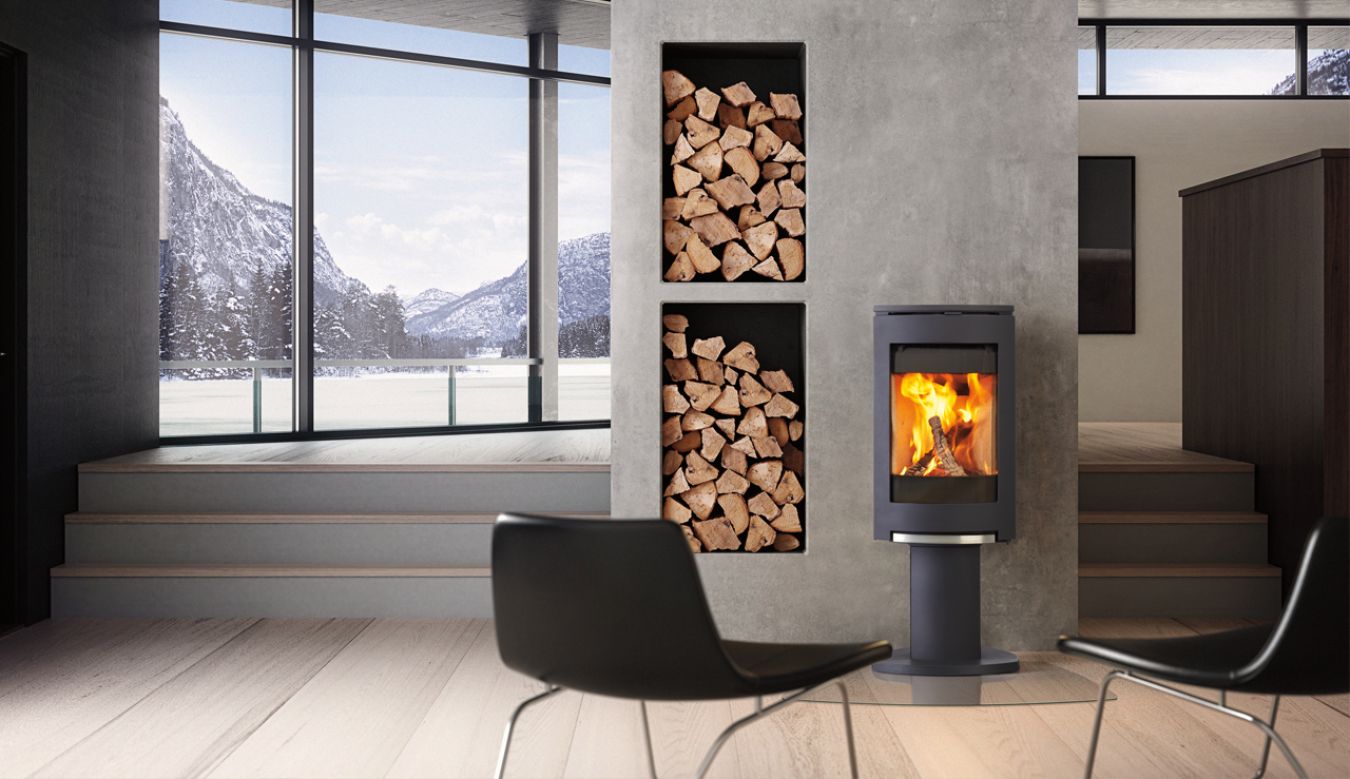Safely Remodeling A Living Room for A Wood Stove - Clearances
Image Courtesy of Jotul Wood Stoves
Determining The Right Clearance For Your Wood Stove and Reducing it Safely
Installing a wood stove into your Ann Arbor home is a magnificent upgrade that's both beautiful and practical. When installing a wood stove, it's critically important for follow the manufacturers instructions for a safe install, and understanding how those instructions are defined.
Almost all current wood stoves available will have a label on the back of the unit that will show how much clearance is needed between the unit and any combustible materials like walls, fabrics, and furniture. This information can also be found in the installation instructions that came with your stove. If there is no label on the unit, the stove is not certified.
The Importance of Installing A Certified Wood Stove
Today, most new wood stoves offered for sale carry a safety certification label on the unit itself. A stove that has not been tested and certified can include those purchased used, stoves found in antique shops and those that have been built by small, local welding shops.
It's best to avoid uncertified stoves for serious heating use because their safety, reliability, and efficiency are likely to be sub-standard. As a result, most insurance companies will not issue coverage if your home contains an uncertified unit.
Because they have not been safety tested, their actual performance is unknown, and as a result, the minimum clearance for surrounding combustible materials can be quite large: 48-inches for radiant stoves and 36-inches for stoves that are surrounded by convection airflow jackets.
Learn About Choosing a Fireplace When Remodeling
The Importance of Clearance Information Provided By The Manufacturer
Certified wood stoves will come with detailed instructions for installation and clearances provided by the manufacturer. For example, the definition of non-combustible materials will be specific to the product and manufacturer you choose.
Wall coverings like tile, brick, stone, and metal are defined as non-combustible, the underlying structure often contains materials which can burn if placed under enough heat like wood, paper faced drywall or insulation. So to be safe, you will need to consider the entire wall structure and assembly surrounding the unit.
As a general guide, stove and flue clearances are unique and specific to a particular product, manufacturer or model of wood stove. These requirements are typically found in the installation manual. This is the documentation that your local building code official will ask to see before inspecting the installation.
Heat Shields and Venting Requirements
When installing a wood stove, the goal is to take up as little floor space as possible. That's why many manufacturers will sell optional heat shields that can be attached to the back, sides, and bottom of their stoves to safely reduce clearances. Heat shields are also available for single wall flue pipes often used for horizontal runs close to a ceiling.
Depending upon the manufacturers specific venting requirements, if you are considering where and how to run the flue pipe, you may want to consider using a double or triple wall insulated flue pipe to pass through the wall or ceiling to the exterior of your home.
Another consideration is the floor area surrounding the stove. Although it will not heat up enough to burn, (stoves are tested for floor temperature during certification) the floor area must be protected from live embers that may fall from the stove when tending the fire. Typically this consists of using a durable non-combustible material like sheet metal, grouted brick or tile. Floor pads should be installed over sub-flooring, not carpeting.
The Final Step...
Always make sure that you read and follow the manufacturer's installation instructions completely. A qualified installer will understand the importance of meeting codes for safety and will have the experience to maximize the efficiency of your stove with proper installation. When your installation is complete, your local building inspector will ask for a copy of the installation instructions before inspecting and approving your wood stove. This allows them to go through the process to make sure that the proper steps and precautions were followed.
Because they will have the final say, it's probably a good idea to check with your local building department before permitting and installation. A qualified professional contractor will understand the importance of working with local officials and codes and will take care of all of the necessary paperwork and inspections.
For MORE INFORMATION: Visit our Home Page to learn about our complete list of services.
A wood stove is a great affordable way to heat your Ann Arbor home throughout the winter. If you're considering adding a wood stove, speak with the experts at Forward Design Build Remodel. We can make sure your project is done quickly and safely!
Forward Design Build is a residential design-build firm in Ann Arbor, Michigan that is known for its commitment to craftsmanship and communication. We are committed to improving our neighbors quality of life with inspired design and creative remodeling. Our homes are highly functional, exquisitely beautiful, and remarkably comfortable. Contact us to speak with an expert about your new home or remodeling project.

